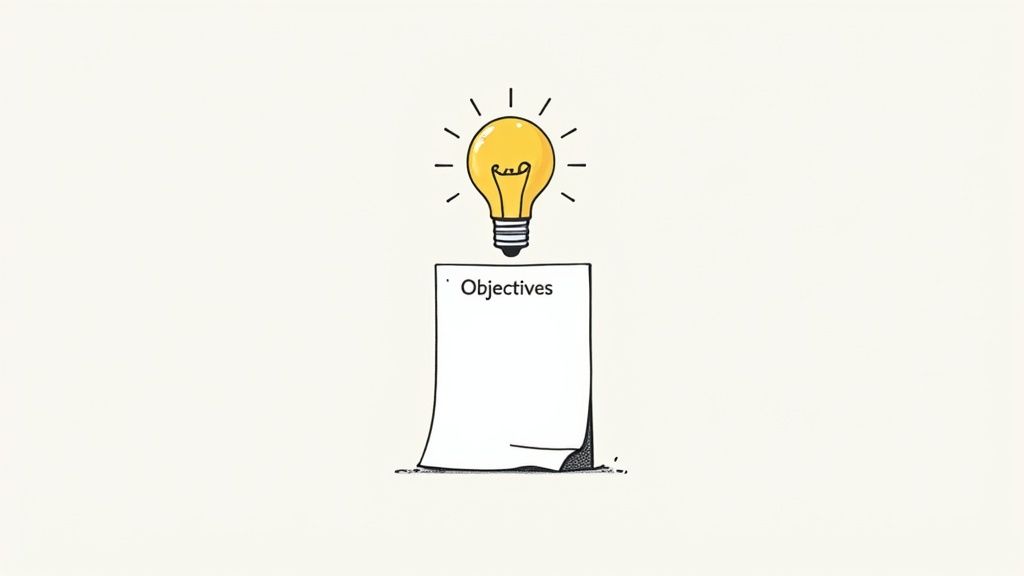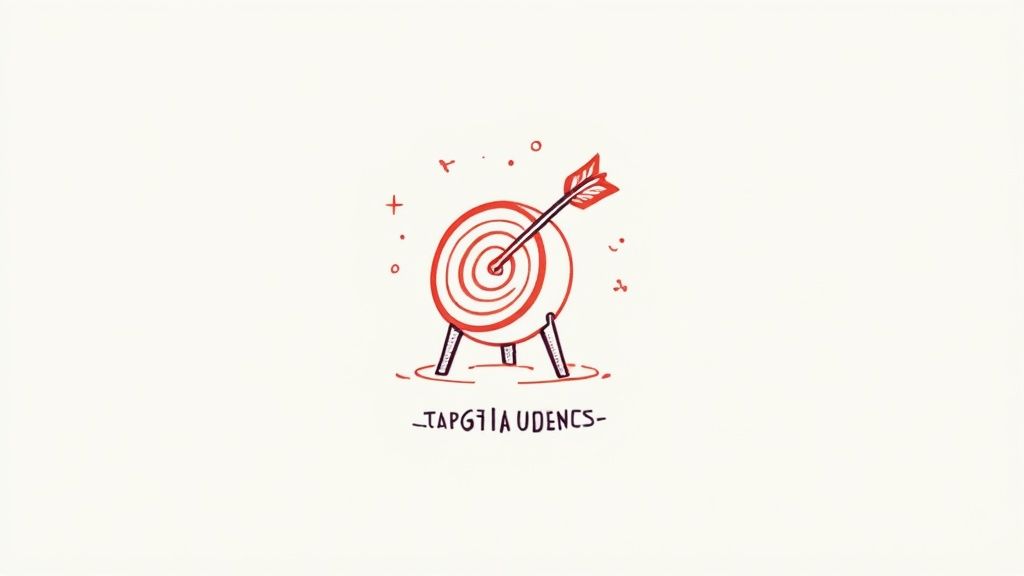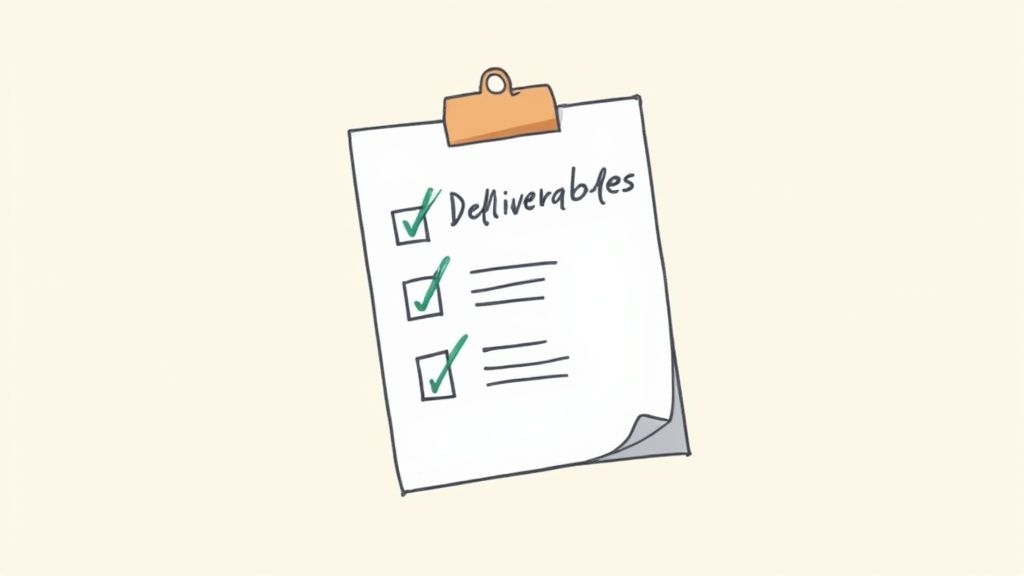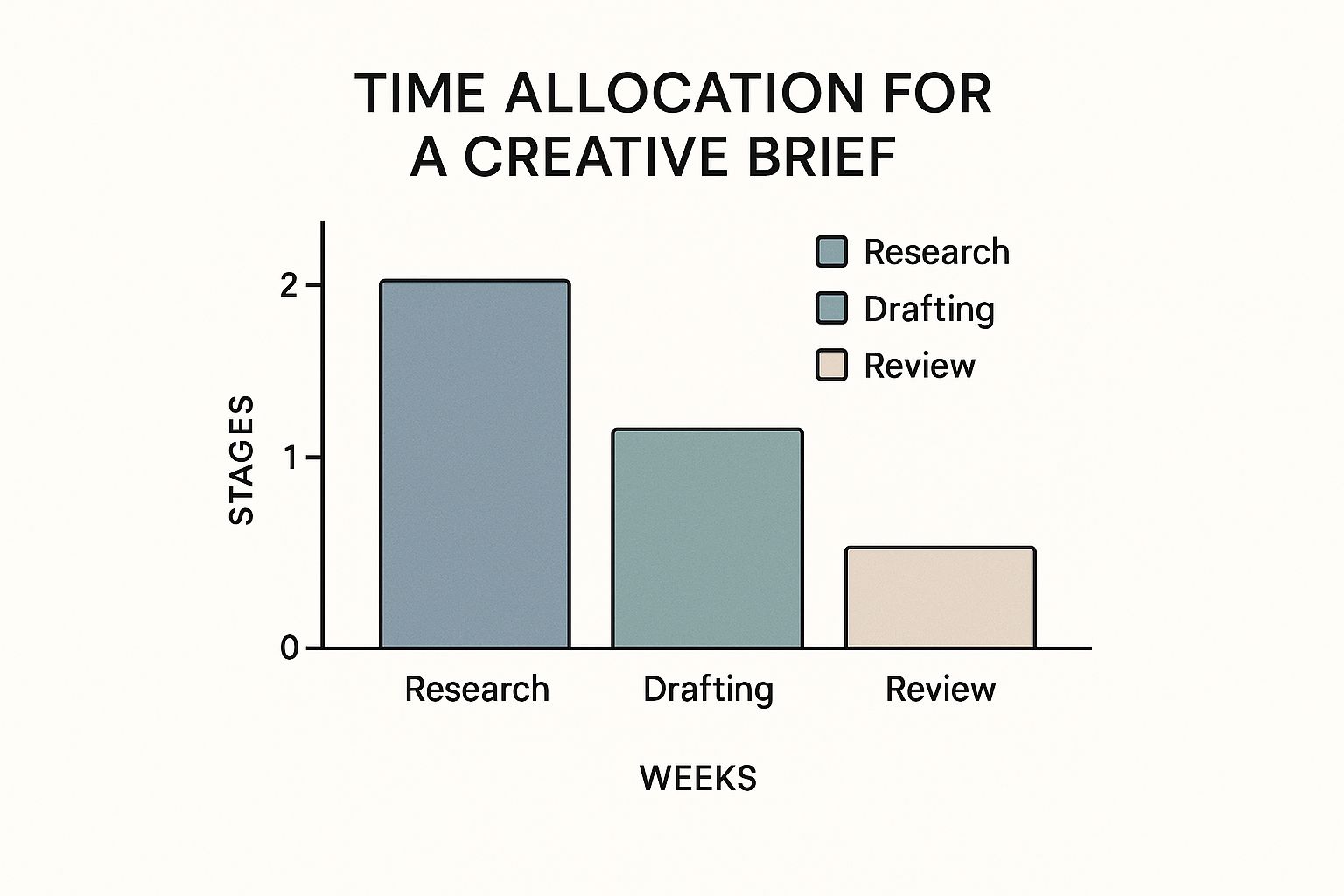Writing a creative brief is all about laying a solid foundation. It’s where you define what you’re trying to achieve, who you’re talking to, what the competition is up to, and—most importantly—the one clear message you need to land. This isn’t just paperwork; it’s a strategic document that gets everyone on the same page before a single creative idea is born.
Why a Great Creative Brief Is Your Most Valuable Asset

Before diving into how to write a creative brief, you first need to appreciate why it’s the bedrock of any successful project. A great brief is far more than an administrative hurdle; it’s your project’s constitution. Think of it as the single source of truth that heads off misalignment, scope creep, and those costly, soul-crushing revisions down the road.
Honestly, it’s the strategic roadmap everyone agrees to follow.
When done right, the brief ensures every single person involved—from the marketing manager to the graphic designer and the copywriter—is working toward the same goal. Without that shared understanding, teams are left to work on assumptions, and that’s a recipe for work that misses the mark and burns through time and money. A well-crafted brief is your best defense against project chaos.
The Foundation of Strategic Alignment
At its heart, a creative brief wears three different hats: it’s a contract, a source of inspiration, and a set of guardrails.
As a contract, it formalizes the project’s goals, deliverables, and what success actually looks like. This gets every stakeholder to agree on what “done” and “successful” mean from the very beginning. Getting this alignment is crucial for smooth creative operations management because it cuts down on the friction between teams.
As an inspiration tool, it digs into the “why” behind the work. It gives your creative team a genuine understanding of the audience’s real-world problems and the business’s objectives, which empowers them to find brilliant solutions instead of just checking boxes.
A brief shouldn’t hand over the creative solution; it should create a space where the right solution can be found. It defines the sandbox but lets the creatives build the castle.
Preventing Revisions and Empowering Creatives
That effort you put into the brief upfront? It pays off big time throughout the project. The number one cause of endless revision cycles is simple misunderstanding. A clear, thoughtful brief slashes that ambiguity, with some research suggesting it can boost project efficiency by up to 40%.
When your creative team has total clarity on these key elements, they can move forward with confidence:
- The Core Problem: What specific challenge are we trying to solve for our audience with this work?
- The Desired Action: What, exactly, do we want people to think, feel, or do after they see this?
- The Success Metrics: How will we know, with actual data, if this campaign worked?
Providing these guardrails doesn’t stifle creativity; it focuses it. You’re giving your team the freedom to explore and innovate within a smart, strategic framework. The result is work that’s not just imaginative, but incredibly effective.
Defining Your Project Objectives and Core Message

Launching a campaign without clear objectives is like starting a road trip with no destination. Sure, you’ll burn through your budget, but you won’t end up anywhere meaningful. Before your creative team can even begin brainstorming, they need a finish line to run toward. This is why nailing down your project objectives and core message is the most crucial part of writing a great brief.
Ambiguous goals like “increase brand awareness” or “drive more traffic” just don’t cut it. They’re too fluffy and don’t give your team the guardrails they need to make smart, strategic creative decisions. Your job is to translate those broad business wishes into sharp, measurable targets.
For instance, “increase brand awareness” needs to become something like, “Achieve a 25% lift in brand recall among our target demographic in the next six months.” Now that is a goal a creative team can sink their teeth into.
Setting Specific and Measurable Objectives
The whole point here is to define what success actually looks like, in no uncertain terms. What tangible business result will this creative work drive? Your objectives need to be so specific that anyone on the project can look at the results and know, without a doubt, whether they hit the mark.
Let’s look at how to transform those vague goals into real, powerful objectives:
- Instead of: Boost sales.
- Try: Generate a 15% increase in online sales for our new product line within Q3.
- Instead of: Get more leads.
- Try: Increase marketing qualified lead (MQL) submissions through our campaign landing page by 30% over the next 90 days.
- Instead of: Improve customer engagement.
- Try: Drive a 20% increase in comments and shares on our social media campaign content.
This isn’t just a “nice-to-have”—it’s an essential part of any modern brief. In fact, taking the time to specify measurable goals has been shown to boost project efficiency by up to 40%, mostly because it slashes the time wasted on misunderstandings. You can find more great insights on what goes into an effective brief over at Adobe Business.
Articulating the Core Message
Once you’ve set your destination (the objectives), you need a North Star to guide the journey. That’s your core message. It’s the single most important idea you want to get across. If your audience only remembers one thing from this entire campaign, what do you want it to be?
This isn’t your tagline. It’s the central thought that will inspire every creative asset. It should clearly state the problem you solve for the customer and the unique value you deliver.
What is the single-minded proposition? A great way to find it is to complete this sentence: “We are creating this campaign so that our audience will think ____, feel ____, and do ____.” The answer is the heart of your message.
Imagine you’re briefing a campaign for a new meal delivery service aimed at busy professionals. The core message could be: “Our service gives you back your weeknights by providing healthy, delicious meals without the work.” Every ad, email, and social media post would then grow from that central idea of reclaiming time and health.
This clarity—on both your objectives and your message—is your best defense against a project that veers off course. It keeps everyone focused, aligned, and ultimately, producing work that delivers real business results.
Bringing Your Target Audience to Life

You can’t create work that connects with a vague, faceless demographic. To get truly impactful results, you have to move beyond generic descriptions like “males, 25-40” and paint a vivid, human picture of who you’re talking to. Your creative team needs to feel like they know this person.
Think of it this way: you’re not building a collection of stats. You’re building a rich, data-driven persona—a real individual with a name, a job, frustrations, and goals. This is the only way for your team to develop concepts that genuinely land and inspire people to act.
Digging Beyond Demographics
Demographics are just the starting point. The real magic happens when you uncover the psychographics—the attitudes, beliefs, and values that actually drive their behavior.
To get the full picture, you need to answer some deeper questions. What do they really care about? What keeps them up at night? Where do they hang out online, and who do they trust for advice? Your goal is to understand their world so thoroughly that you can anticipate their needs and speak their language.
The most powerful creative briefs transform the target audience from a statistic into a story. When a creative can visualize the person they’re trying to help, their work becomes exponentially more empathetic and effective.
To build this profile, you need to gather insights from a few different places. Don’t just guess; dig into the data you already have.
- Website Analytics: Look at user behavior flows, popular content, and the search terms people use on your site. This tells you what they’re actively looking for.
- Social Media Listening: Monitor conversations about your brand, your competitors, and the industry. You’ll uncover pain points and desires in their own words.
- Customer Surveys and Interviews: Go straight to the source. Ask your best customers about their challenges, goals, and what motivates them. Nothing beats hearing it directly.
- Sales Team Feedback: Your sales team is on the front lines. They have invaluable, real-world insights into customer objections and what truly closes a deal.
From Data to Detailed Personas
Once you’ve gathered your research, it’s time to piece it all together into a compelling persona. This isn’t just about listing facts; it’s about crafting a narrative that feels real.
Using data-driven consumer profiling to build realistic personas is a proven method for grounding your creative work in reality. It replaces assumptions with actual insights. In my experience, brands that do this well often see a 25-30% increase in consumer engagement. You can discover more about how data shapes effective briefs over at GWI.
A well-defined persona is a critical step in writing a brief that actually works. For a structured way to build out these profiles, check out our guide with a free customer persona template.
By bringing your audience to life with this level of detail, you empower your creative team to stop making ads and start having conversations.
Assembling the Core Elements of Your Brief
Once you’ve nailed down your objectives and have a living, breathing picture of your audience, it’s time to build the brief itself. This is where you assemble all the essential pieces into a single, clear document that steers your team without putting their creativity in a straitjacket.
The whole game is about balance. You need to provide enough direction to eliminate guesswork, but not so much that you’re practically designing the ad yourself. It’s about giving your creative team the “what” and the “why,” then trusting them with the “how.”
Laying Out the Competitive Landscape
First, paint a clear picture of the competitive arena. This isn’t the time for an exhaustive market analysis. Instead, focus on who your target audience sees as the main alternatives to your brand.
Pick out 2-3 key competitors. Briefly touch on what they do well and, more importantly, where they fall short. This context is gold for your creative team. It shows them the battlefield and helps them spot the perfect opening to make your brand stand out. If you need a refresher, our guide on effective brand positioning strategies can help you find that unique angle.
Defining Key Deliverables and Specs
This is where you need to be ruthlessly specific. Any fuzziness here will almost certainly lead to painful revisions and wasted hours. “A few social posts” just won’t cut it.
Get granular. Spell out exactly what you need.
- Format and Quantity: For example, three static Instagram posts at 1080x1080px and two 15-second TikTok videos.
- Technical Specs: List the required file types (JPEG, MP4, etc.), resolution, and any other specs tied to the platform.
- Mandatory Inclusions: Make a simple checklist of any logos, taglines, URLs, or legal copy that absolutely must be in the final work.
Getting this right from the start means everyone shares the same definition of “done.”
Outlining Timelines and Stakeholders
A project without deadlines is just a wish. You need to map out the key dates, from the initial kickoff meeting all the way to the final handoff.

As this breakdown shows, a huge chunk of time is spent on research and prep before the brief is even finalized. Don’t skimp on this part.
Alongside the schedule, identify the key players and what they’re responsible for. Who’s giving the feedback? Who has the final say? Clarifying this up front saves a world of confusion and keeps the project from stalling.
A great creative brief is both comprehensive and concise. The secret is to include only what’s essential and link out to everything else. Your brand guidelines, detailed research, or past campaign examples can live in a shared folder, keeping the brief clean and focused.
Finally, think about consistency. Research from Smartsheet shows that using a standardized template for your briefs can cut down project start times by a massive 20%. By sticking to the essentials—goals, audience, deliverables, and timeline—you create a predictable, efficient workflow that everyone can rely on.
How to Write a Brief That Truly Inspires
A brief can tick all the technical boxes and still land with a thud. You can have all the right information, but if it doesn’t light a fire under your creative team, it’s just a document. We’ve covered the essential building blocks, but now we get to the art of it. The real goal isn’t just to inform your team; it’s to make them so curious and excited they can’t wait to tackle the challenge.
It really comes down to your tone. Think of the brief as the start of a great conversation, not a set of marching orders from on high. When you write with an encouraging, collaborative voice, you’re telling your team you trust their expertise. That simple change in perspective can transform a “task” into a shared mission.
Frame the Problem as an Opportunity
The words you choose have a huge impact on how your team approaches the work. One of the most powerful shifts you can make is to frame the project’s challenge as an exciting opportunity. This moves the focus from “fixing something that’s broken” to “creating something new and valuable.”
Just look at the difference.
- Restrictive Phrasing: “Our click-through rates are down 15%. We need three new ads to fix this. The ads must feature our product and the tagline.”
- Inspirational Phrasing: “We have an incredible opportunity to show our audience a new way to solve a problem they struggle with every day. How can we create a campaign that makes them feel truly seen and offers a solution so compelling they can’t help but learn more?”
The first example is a paint-by-numbers assignment that guarantees mediocre work. The second is an open invitation to innovate, connect, and think big. It sets the destination without dictating the exact route—and that’s the sweet spot for a great brief.
Speak Human, Not “Corporate”
Let’s be honest: your creative team thinks in stories, emotions, and big ideas. If you bog them down with corporate jargon and a sea of marketing acronyms, you’re creating a massive disconnect from the project’s soul. Write the brief in plain, simple English that anyone can get behind.
Your brief is the bridge between the world of business objectives and the world of creative ideas. For that bridge to be sturdy, it needs to be built with language both sides understand. Ditch the jargon and speak with clarity and passion.
So instead of saying, “We need to leverage our core competencies to drive synergy and increase Q3 conversions,” try this: “Let’s show our customers that we’re the best at solving this specific problem for them. What’s the most powerful story we can tell to earn their trust and their business this quarter?”
This isn’t about dumbing anything down. It’s about translating business goals into human challenges—the kind of challenges creative minds are wired to solve.
Get Buy-In Before You Hit ‘Send’
Finally, one of the best ways to guarantee an inspiring brief is to stop writing it in a silo. Bring in your creative lead or a senior creative during the final drafting stages. They have a knack for spotting gaps, unclear language, or anything that might accidentally box in the team’s thinking.
This little bit of early collaboration is a game-changer. It does two things:
- It makes the brief stronger. The creative lead will ask the same tough questions their team will, letting you sharpen your points before the official kickoff.
- It builds instant ownership. When the creative team feels like they had a voice in shaping the direction, they become deeply invested in the project’s success.
By working together, the brief stops being a document you hand off and becomes a shared plan everyone is genuinely excited to bring to life.
Common Creative Brief Questions Answered
https://www.youtube.com/embed/lO27HC2Jcbk
Even with a great template in hand, you’re bound to hit a few roadblocks when your team starts pulling a creative brief together. Getting ahead of these common questions is what separates a good process from a great one. Let’s dig into some of the issues I see come up time and time again.
How Long Should a Creative Brief Be?
Everyone wants a magic number, but the truth is, it’s about clarity, not word count. A truly effective brief is something anyone—from the CEO to a junior designer—can read and understand in just a few minutes.
As a rule of thumb, aim for one to two pages. If you find yourself creeping onto page three, it’s a big red flag that you’re probably getting bogged down in the weeds. The brief is the sharp, focused summary, not the entire library of research.
Here’s a trick I’ve used for years: take all that supporting material—the dense market research, full brand guidelines, or past campaign reports—and move it into a separate folder. Then, just link to it from the brief. This keeps your core document clean, scannable, and focused on what truly matters.
Who Should Write the Brief?
This is a big one. A creative brief should never be written in a vacuum. While the whole process is usually spearheaded by an account manager or a project manager who wrangles all the information, it has to be a team sport.
The best briefs I’ve ever worked with always had input from a few key players:
- Key Stakeholders: The marketing director or brand manager needs to weigh in on the business goals, the budget, and what success actually looks like.
- A Creative Lead: Getting a senior creative—like a design lead or copy chief—involved in the final draft is a total game-changer. They know what their team needs to get inspired and can spot any missing information from a mile away.
When you bring these people together, you create a shared understanding from day one, which is invaluable.
The single biggest mistake is being too prescriptive about the creative execution. A brief should define the problem, the audience, and the objective—it should not dictate the solution. Avoid saying, “Make it look like this competitor’s ad.” Your role is to provide the “what” and “why,” freeing the creative team to figure out the “how.”
Can I Use the Same Template for Every Project?
Absolutely. In fact, you should. Having a consistent template is one of the best things you can do for efficiency. It creates muscle memory for your team and ensures you don’t miss critical details. Some data even suggests it can cut down project start-up times by 20%.
But—and this is a big but—your template should be a living document, not a stone tablet. You have to be willing to adapt it. A brief for a quick-turnaround social media ad will look very different from one for a massive brand launch. Think of your template as the foundation, but always be ready to tailor it to the specific scope and complexity of the project at hand.
At ReachLabs.ai, we specialize in turning strategic insights into compelling creative that gets results. Our team works with you to build briefs that inspire action and drive measurable growth. Discover how our collective approach can elevate your brand’s voice.





